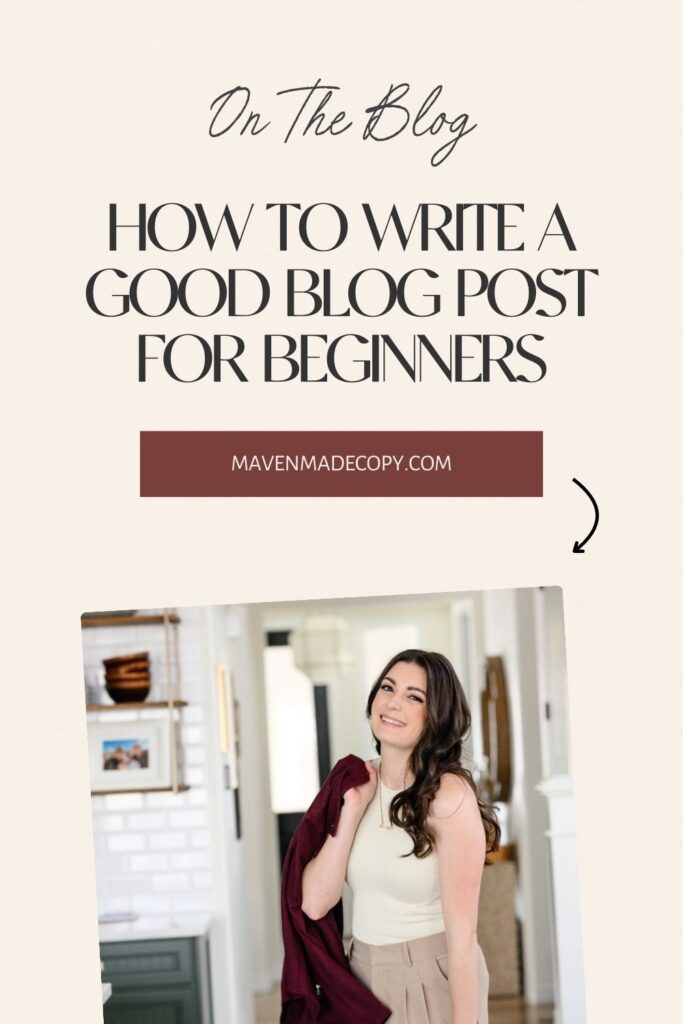Get a copy of the exact blog content calendar template I use for myself and my clients (for freeee!)
Browse by Category
I infuse personality and SEO to get you the blog results you've been looking for. Want to learn about how we can work together?
I'm the blog writer behind Maven Made Copy.
Hey, I’m Eden
Download my blog content calendar for FREE!
Blogging is still a strong marketing tool for all businesses, as long as you know how to write a good blog post.
And before you ask, no, blogging is NOT dead. The strategy just looks a little different now that AI is in search.
I was recently in a group mentorship program for copywriters called Success Story. I was the go-to blog girlie, and someone asked me what a good blog should include.
My immediate response? “Where do I even begin?!”
There’s soooo much that goes into a blog, which is one of the many reasons why I decided to niche my business to focus only on blog writing.
I started to type a response, but I figured many business owners probably have the same question.
So thank you, Jason, for inspiring this blog post. I hope it helps beginners understand how to write a good blog post.

A Compelling Headline
Your blog headline is the first thing people will see when they click on your post. Is it enticing? Does it make them want to learn more?
These types of headlines tend to perform well:
- Listicles: 7 Blog Best Practices to Get You Ranked on Google
- Questions: How Long Does it Take to See Blog Results?
- How-to’s or step-by-step: How to Repurpose Content to Maximize Your Time and Energy
- Dates: What’s Next in Email Marketing for Creatives in 2025?
I tend to write a lot of how-to and question posts. I enjoy educating my audience on blog and SEO best practices, and those headline types align with that kind of content.
Learn how to write a good blog post by starting with a headline that promises value and sparks curiosity.
Read this blog to learn how to write a headline that gets clicks!
A Strong Introduction Paragraph
An introduction paragraph should capture readers’ interest within the first few sentences. What is going to make them want to continue reading your blog post?
Consider adding these hooks in your intro paragraph:
- Questions: Make the intro conversational with your reader.
- Stats: Share a shocking statistic your reader can relate to.
- Stories: Everyone loves a good story that seamlessly leads into business content.
- Bold statements: Catch your reader off guard with an unpopular opinion, challenge a popular belief, or give a big promise.
Clear Structure and Readability
Let’s be honest—people usually don’t read an entire blog. If you’re reading this sentence right now, hiiiii you’re my favorite 🫶
Readers usually skim headlines and bullet points to get the gist, and if they want to learn more, they might read the rest of the content.
That means you need descriptive headlines and a specific structure throughout your blog to engage your reader, no matter how much they read.
Every blog post should have these elements:
- Subheadings (H2s, H3s, and maybe H4s)
- Short paragraphs (I’m talkin’, like, 1-2 sentences)
- Bullet points
Improving the readability of your blog keeps people on your website longer, boosts SEO, and encourages sharing.
This is a super easy blog update you can do!
Valuable, Well-Researched Content
So, obviously, you need valuable content. No one wants to read a bunch of junk—outdated, boring, overall not helpful AT ALL… you know the type.
When picking a blog topic, focus on solving a problem or answering a question.
I usually write about super specific topics to avoid being too generic or writing 10,000 words to thoroughly explain a broad topic.
Here are 16 places you can find blog topic inspiration.
Then you need to have the expertise to write about your chosen topic. Don’t even think about copying and pasting from AI just to publish a new blog post. I won’t go down that rabbit hole right now, but you can read about my thoughts on AI right here.
If you need some data to back up your thoughts, cite credible sources, data, and examples. People actually appreciate outside examples and opinions in content. It proves you aren’t just pulling things out of thin air—other people are backing you up.
Keyword Research
Every blog needs keyword research. I always do keyword research before writing, so I have my focus keyword in the back of my mind.
I like to use Ubersuggest for my keyword research—here’s a step-by-step guide on how to use it.
I’m looking for keywords that are high in volume and low in competition, but sometimes, those keywords are impossible to find with certain topics. In that case, I try to stay below a 60 for competition and at least 100 search volume.
Here’s a guide on choosing the right keywords for your blogs.
Your keyword should be in your:
- Headline
- Blog content
- Alt text (if applicable)
- URL slug (if applicable)
- SEO metadata
Read this blog to learn why it’s important to have your focus keyword in these places.
SEO Metadata
Many business owners struggle with how to write a good blog post that ranks well on Google.
Maybe it’s not your content (I’m sure what you’re writing is amazing!), but it’s actually your SEO metadata that’s preventing you from ranking.
If you don’t write your own SEO title and meta description, your website will just pull something random for you. Usually, it’s your blog headline as the SEO title and the first sentence of your introduction paragraph as the meta description.
“Well, what’s wrong with that? That’s what I would put anyway.”
True—your blog title will most likely be your SEO title because that’s the topic of the blog. Duh.
However, sometimes your blog title is too long to be an SEO title. SEO titles can only be up to 55 characters long. If your blog title is longer than that, it’ll show an ellipsis in search results, and that’s not very user-friendly, if you ask me.
Here’s an example of mine (oops, BRB changing this right now):

Providers? People? Monkeys? IDK, but I need to shorten this SEO title to fit the 55-character limit, so people know exactly what they’re clicking on.
As for your meta description, the first sentence of your blog isn’t good enough. It probably doesn’t accurately describe the blog.
You might be starting a story, sharing a statistic, or asking a question, which are all great introductions, but not great meta descriptions.
A meta description needs to describe the blog content in fewer than 150 characters. Or, once again, it’ll show an ellipsis:

Not me completely exposing myself today 🙃
Write better SEO metadata than I do for myself.
Internal Linking
This means linking from one page on your website to another. You’re providing more resources for readers to explore, keeping them on your website longer and increasing the chances they convert by downloading a freebie or inquiring.
Have you noticed how many other relevant blog posts I’ve been linking to in this post? I have more content on the topics I’m talking about in this blog, and I want to provide you with that resource if you want to learn more.
That’s one way internal linking boosts SEO—keeping people on your website longer.
But it also helps search engines discover new pages on your website and index them faster.
Search engines will “read” a blog post and see each link you have. It’ll then follow those links and discover those pages. Then on those pages, there will be more links that it will follow, so on and so forth.
The more search engines understand your website, the more they begin to trust it as a valuable resource and show your content in search results.
Here’s more about why internal linking is important for SEO.
Again, another easy blog update to make! Add some new links to old blog posts.
Images with Alt Text
Do you even need images in your blog post? Sometimes, maybe, but maybe not—find out here if you should use images.
If you do decide to use images, they absolutely need alt text.
Alt text is a short description of the image. Search engines use it to rank the image in search results. People who use screen readers need alt text to understand the image—the screen reader will read the alt text out loud since the person can’t see the image.
Alt text is easily missed, but it’s a super important SEO best practice.
Clear Voice and Personality
Blogs don’t need to be stuffy and professional to be valuable. Add some personality and tone of voice to make them more engaging!
Here are some ways to do that:
- Tell stories
- Add italics, bolding, underlining, etc.
- Throw in emojis
- Write conversationally
- Sprinkle humor
- Be honest
A Call-to-Action (CTA)
Think about the next step you want someone to take after they read your blog.
Is it:
- Downloading a freebie
- Subscribing to your newsletter
- Buying a product
- Sharing on social
- Inquiring about working with you
- Reading more blogs
Pick one final CTA and share it at the end of your post. Make it super clear what you want them to do next.
Optional: FAQs
I’m putting this as optional (but it really shouldn’t be if you want to know how to write a good blog post). An FAQ section at the end of your blog addresses any final points you didn’t have a chance to talk about in the copy but still want to mention.
But its main purpose is for search engines and AI.
Here’s a little tip for you—pull FAQ questions directly from the People Also Ask section of Google. These are questions you 100% know people are searching for, and if you provide a better answer than the one listed, you could be the new reference!
And the same idea goes for AI Overviews. AI Overviews are very question-based, meaning they directly answer questions vs. general queries. If you have a valuable response to the question, they may just summarize your answer and cite you as a source.
The Step-by-Step Process for How to Write a Good Blog Post
Now that you know the key elements, you’re ready to put them into practice and master how to write a good blog post.
As you can see, there’s a LOT that goes into a good blog post. It takes a good strategy to find keywords, write for a specific audience, apply SEO and AI best practices, and increase the chance of conversion at the end.
Get more tips like this every week!
FAQs About How to Write a Good Blog Post
Is blogging dead due to AI?
No, the strategy just looks a little different now. AI literally needs us to create content to summarize and cite. And search engines aren’t going to penalize us for continuing to provide value to our audiences.
Why do most bloggers fail?
Blogs fail because the writer doesn’t understand the SEO strategy behind blogging. They might be amazing writers and produce really valuable content, but if they don’t understand how to get it in front of the right people, it’ll just be one of the billions of pages on the internet getting zero traffic.
Can you tell if a blog was written by AI?
People have started to notice when content is written by AI. It immediately loses credibility and could even be removed from search engines. Tools like Grammarly can point out content that appears to be written by AI, but it’s not perfect.
AFFILIATE DISCLAIMER
Some links in this blog post may be affiliate links. I only recommend products and services I trust and believe would be beneficial to you.
More For You To binge
The blogger and SEO specialist behind Maven Made Copy
I combine creativity, personality, and data-driven strategies to craft blogs that align with your mission - to serve your customers beyond their expectations.
Thanks for Reading!
Wondering how you can get blogs just like this on your website? See how my blog writing services can elevate your content and website traffic!
full service blog writing
podcast show notes
blog optimization
blog strategy
You don't have to stress about publishing new blog posts anymore. My done-for-you blog writing includes everything from topic ideation, researching, writing, strategy, publishing, and reporting.
Easily repurpose your podcast into a blog post! Boost your organic search traffic and gain new listeners every week.
Got some old blog posts on your website that could use some updates? I'll get them updated and optimized for SEO.
Like writing but don't know what to write about or the strategy behind it? I would love to work with you on a done-for-you blog strategy and content calendar.
Let's work together
get more strategic
time to repurpose
make some updates
Like what you're reading?
Then you'll love my newsletter, Copy Connections! You'll get one blog, SEO, or marketing tip in your inbox every Wednesday. Plus, you can ask me questions that will be featured in future newsletters!



